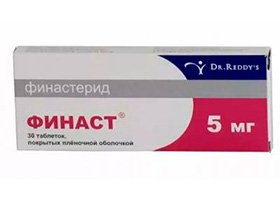
All iLive content is medically reviewed or fact checked to ensure as much factual accuracy as possible.
We have strict sourcing guidelines and only link to reputable media sites, academic research institutions and, whenever possible, medically peer reviewed studies. Note that the numbers in parentheses ([1], [2], etc.) are clickable links to these studies.
If you feel that any of our content is inaccurate, out-of-date, or otherwise questionable, please select it and press Ctrl + Enter.
Finast
Medical expert of the article
Last reviewed: 04.07.2025

Finast has an anti-anthrogenic effect and affects metabolic processes within the prostate tissue.
The effect of finasteride is based on the inhibition of the therapeutic activity of the enzyme 5-α-reductase. As a result, the conversion of testosterone into an active androgenic hormone - 5-dihydrotestosterone - is prevented. The values of this androgen are reduced both in the blood and in the prostate, thereby preventing the growth of tissues of this gland.
The therapy results in a reduction in the size of the prostate and reduces the intensity of the symptoms of the disease.
ATC classification
Active ingredients
Pharmacological group
Pharmachologic effect
Indications Finasta
It is used for prostate adenoma when it is necessary to achieve the following improvements:
- reduce the size of the gland if benign hyperplasia is observed;
- increase the speed of urinary outflow processes;
- reduce the intensity of hyperplasia signs;
- reduce the likelihood of the need for emergency surgery due to acute urinary retention.
Release form
The drug is produced in tablets - 10 pieces inside strips. There are 3 such strips in a box.
Pharmacokinetics
The element finasteride is absorbed at high speed inside the digestive system. Bioavailability values are 80%.
Blood Cmax values are noted after 60-120 minutes from the moment of taking the drug. Finasteride has a high level of synthesis with intraplasmic protein - up to 90%.
The metabolic processes of the drug are carried out inside the liver, and the excretion of metabolic elements occurs with urine and feces.
Dosing and administration
The medication is taken daily for at least six months. In approximately half of the patients, clinical manifestations of the pathology disappear approximately after 1 year from the start of therapy.
A maximum of 5 mg of the drug is taken per day. The dosage is administered in 1 dose, without reference to food intake.
Use Finasta during pregnancy
The medication is prescribed only for the treatment of the prostate in men, so it is not used during breastfeeding or pregnancy.
Side effects Finasta
Among the side effects of the drug:
- signs of allergy to elements of the drug;
- gynecomastia;
- loss of sexual desire or weakening of libido;
- decrease in ejaculate volume;
- a slight increase in FSH, LTH and testosterone levels that does not exceed the normal range.
Negative manifestations develop extremely rarely and often disappear on their own after some time, without stopping treatment.
Storage conditions
Finast should be kept in a dark and dry place at standard temperature.
 [ 11 ]
[ 11 ]
Shelf life
Finast is allowed to be used within a 24-month period from the date of manufacture of the drug.
Application for children
Finast cannot be used in pediatrics.
Analogues
The analogs of the drug are Adenosteride-Zdorovye, Finpros, Urofin, Penester with Prosteride, and also Proscar, Finasteride, Prostan and Finister.
 [ 12 ]
[ 12 ]
Reviews
Finast gets good reviews from patients - the drug is really effective, but only if the full treatment cycle is completed. The disadvantages include the fact that in the first week or month of therapy, libido often weakens, but this side effect goes away fairly quickly.
Manufacturer
Attention!
To simplify the perception of information, this instruction for use of the drug "Finast" translated and presented in a special form on the basis of the official instructions for medical use of the drug. Before use read the annotation that came directly to medicines.
Description provided for informational purposes and is not a guide to self-healing. The need for this drug, the purpose of the treatment regimen, methods and dose of the drug is determined solely by the attending physician. Self-medication is dangerous for your health.

